Microsoft AZ-303 Exam Practice Questions (P. 3)
- Full Access (334 questions)
- Six months of Premium Access
- Access to one million comments
- Seamless ChatGPT Integration
- Ability to download PDF files
- Anki Flashcard files for revision
- No Captcha & No AdSense
- Advanced Exam Configuration
Question #21
DRAG DROP -
You are designing a solution to secure a company's Azure resources. The environment hosts 10 teams. Each team manages a project and has a project manager, a virtual machine (VM) operator, developers, and contractors.
Project managers must be able to manage everything except access and authentication for users. VM operators must be able to manage VMs, but not the virtual network or storage account to which they are connected. Developers and contractors must be able to manage storage accounts.
You need to recommend roles for each member.
What should you recommend? To answer, drag the appropriate roles to the correct employee types. Each role may be used once, more than once, or not at all.
You may need to drag the split bar between panes or scroll to view content.
NOTE: Each correct selection is worth one point.
Select and Place:
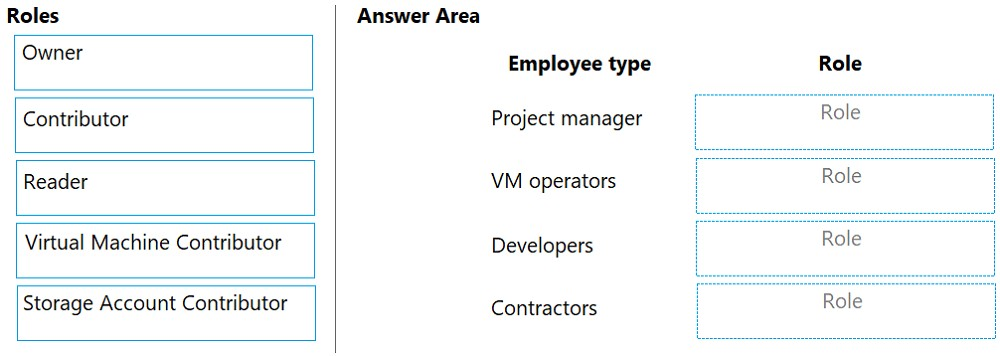
You are designing a solution to secure a company's Azure resources. The environment hosts 10 teams. Each team manages a project and has a project manager, a virtual machine (VM) operator, developers, and contractors.
Project managers must be able to manage everything except access and authentication for users. VM operators must be able to manage VMs, but not the virtual network or storage account to which they are connected. Developers and contractors must be able to manage storage accounts.
You need to recommend roles for each member.
What should you recommend? To answer, drag the appropriate roles to the correct employee types. Each role may be used once, more than once, or not at all.
You may need to drag the split bar between panes or scroll to view content.
NOTE: Each correct selection is worth one point.
Select and Place:

send
light_mode
delete
Question #22
You have an Azure virtual machine named VM1 and an Azure Active Directory (Azure AD) tenant named adatum.com.
VM1 has the following settings:
✑ IP address: 10.10.0.10
✑ System-assigned managed identity: On
You need to create a script that will run from within VM1 to retrieve the authentication token of VM1.
Which address should you use in the script?
VM1 has the following settings:
✑ IP address: 10.10.0.10
✑ System-assigned managed identity: On
You need to create a script that will run from within VM1 to retrieve the authentication token of VM1.
Which address should you use in the script?
- Avm1.adatum.com.onmicrosoft.com
- B169.254.169.254Most Voted
- C10.10.0.10
- Dvm1.adatum.com
Correct Answer:
B
Your code that's running on the VM can request a token from the Azure Instance Metadata Service identity endpoint, accessible only from within the VM: http://169.254.169.254/metadata/identity/oauth2/token
Reference:
https://docs.microsoft.com/en-us/azure/active-directory/managed-identities-azure-resources/overview
B
Your code that's running on the VM can request a token from the Azure Instance Metadata Service identity endpoint, accessible only from within the VM: http://169.254.169.254/metadata/identity/oauth2/token
Reference:
https://docs.microsoft.com/en-us/azure/active-directory/managed-identities-azure-resources/overview
send
light_mode
delete
Question #23
HOTSPOT -
Your company has a virtualization environment that contains the virtualization hosts shown in the following table.

The virtual machines are configured as shown in the following table.

All the virtual machines use basic disks. VM1 is protected by using BitLocker Drive Encryption (BitLocker).
You plan to migrate the virtual machines to Azure by using Azure Site Recovery.
You need to identify which virtual machines can be migrated.
Which virtual machines should you identify for each server? To answer, select the appropriate options in the answer area.
NOTE: Each correct selection is worth one point.
Hot Area:
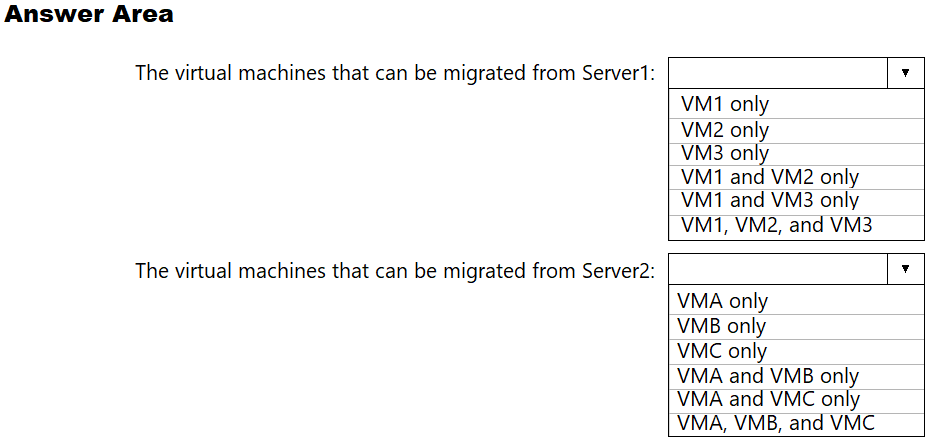
Your company has a virtualization environment that contains the virtualization hosts shown in the following table.

The virtual machines are configured as shown in the following table.

All the virtual machines use basic disks. VM1 is protected by using BitLocker Drive Encryption (BitLocker).
You plan to migrate the virtual machines to Azure by using Azure Site Recovery.
You need to identify which virtual machines can be migrated.
Which virtual machines should you identify for each server? To answer, select the appropriate options in the answer area.
NOTE: Each correct selection is worth one point.
Hot Area:

Correct Answer:
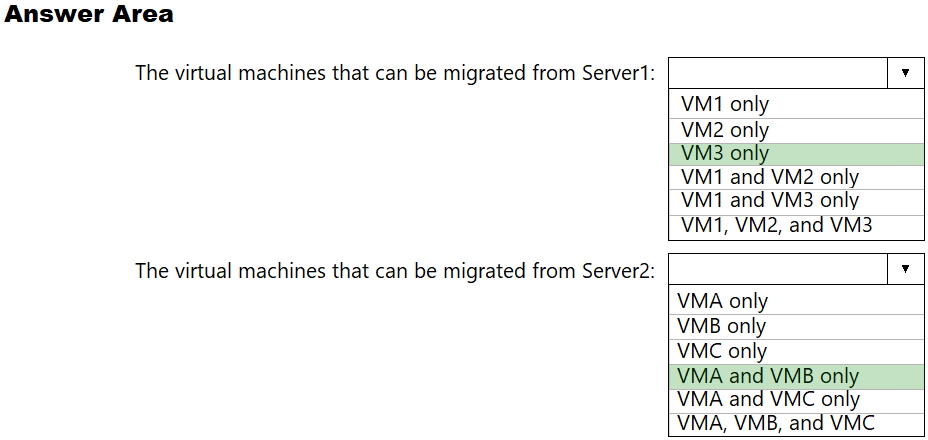
Incorrect Answers:
VM1 cannot be migrates as it has BitLocker enabled.
VM2 cannot be migrates as the OS disk on VM2 is larger than 2TB.
VMC cannot be migrates as the Data disk on VMC is larger than 4TB.
Reference:
https://docs.microsoft.com/en-us/azure/site-recovery/hyper-v-azure-support-matrix#azure-vm-requirements

Incorrect Answers:
VM1 cannot be migrates as it has BitLocker enabled.
VM2 cannot be migrates as the OS disk on VM2 is larger than 2TB.
VMC cannot be migrates as the Data disk on VMC is larger than 4TB.
Reference:
https://docs.microsoft.com/en-us/azure/site-recovery/hyper-v-azure-support-matrix#azure-vm-requirements
send
light_mode
delete
Question #24
You are designing an Azure solution.
The solution must meet the following requirements:
✑ Distribute traffic to different pools of dedicated virtual machines (VMs) based on rules.
✑ Provide SSL offloading capabilities.
You need to recommend a solution to distribute network traffic.
Which technology should you recommend?
The solution must meet the following requirements:
✑ Distribute traffic to different pools of dedicated virtual machines (VMs) based on rules.
✑ Provide SSL offloading capabilities.
You need to recommend a solution to distribute network traffic.
Which technology should you recommend?
- AAzure Application GatewayMost Voted
- BAzure Load Balancer
- CAzure Traffic Manager
- Dserver-level firewall rules
Correct Answer:
A
If you require "SSL offloading", application layer treatment, or wish to delegate certificate management to Azure, you should use Azure's layer 7 load balancer
Application Gateway instead of the Load Balanacer.
Incorrect Answers:
D: Because Load Balancer is agnostic to the TCP payload and TLS offload ("SSL") is not provided.
Reference:
https://docs.microsoft.com/en-us/azure/application-gateway/overview
A
If you require "SSL offloading", application layer treatment, or wish to delegate certificate management to Azure, you should use Azure's layer 7 load balancer
Application Gateway instead of the Load Balanacer.
Incorrect Answers:
D: Because Load Balancer is agnostic to the TCP payload and TLS offload ("SSL") is not provided.
Reference:
https://docs.microsoft.com/en-us/azure/application-gateway/overview
send
light_mode
delete
Question #25
Note: This question is part of a series of questions that present the same scenario. Each question in the series contains a unique solution that might meet the stated goals. Some question sets might have more than one correct solution, while others might not have a correct solution.
After you answer a question in this section, you will NOT be able to return to it. As a result, these questions will not appear in the review screen.
You manage an Active Directory domain named contoso.local.
You install Azure AD Connect and connect to an Azure Active Directory (Azure AD) tenant named contoso.com without syncing any accounts.
You need to ensure that only users who have a UPN suffix of contoso.com in the contoso.local domain sync to Azure AD.
Solution: You use Azure AD Connect to customize the synchronization options.
Does this meet the goal?
After you answer a question in this section, you will NOT be able to return to it. As a result, these questions will not appear in the review screen.
You manage an Active Directory domain named contoso.local.
You install Azure AD Connect and connect to an Azure Active Directory (Azure AD) tenant named contoso.com without syncing any accounts.
You need to ensure that only users who have a UPN suffix of contoso.com in the contoso.local domain sync to Azure AD.
Solution: You use Azure AD Connect to customize the synchronization options.
Does this meet the goal?
- AYes
- BNoMost Voted
Correct Answer:
B
Instead use Synchronization Rules Editor to create a synchronization rule.
Note: Filtering what objects are synced to Azure AD is a common request and there are many instances where filtering by OU just doesn't cut it. One option is to filter users by their UPN suffix so that only users with the public FQDN as their UPN suffix are synced to Azure AD (e.g., [email protected] would be synced while [email protected] would not).
Filtering can be configured using either the GUI (Synchronization Rules Editor) or PowerShell.
Reference:
https://www.sidekicktech.com/blog/field-notes/2019/upn-suffix-filtering-ad-connect/
B
Instead use Synchronization Rules Editor to create a synchronization rule.
Note: Filtering what objects are synced to Azure AD is a common request and there are many instances where filtering by OU just doesn't cut it. One option is to filter users by their UPN suffix so that only users with the public FQDN as their UPN suffix are synced to Azure AD (e.g., [email protected] would be synced while [email protected] would not).
Filtering can be configured using either the GUI (Synchronization Rules Editor) or PowerShell.
Reference:
https://www.sidekicktech.com/blog/field-notes/2019/upn-suffix-filtering-ad-connect/
send
light_mode
delete
Question #26
Note: This question is part of a series of questions that present the same scenario. Each question in the series contains a unique solution that might meet the stated goals. Some question sets might have more than one correct solution, while others might not have a correct solution.
After you answer a question in this section, you will NOT be able to return to it. As a result, these questions will not appear in the review screen.
You manage an Active Directory domain named contoso.local.
You install Azure AD Connect and connect to an Azure Active Directory (Azure AD) tenant named contoso.com without syncing any accounts.
You need to ensure that only users who have a UPN suffix of contoso.com in the contoso.local domain sync to Azure AD.
Solution: You use Synchronization Rules Editor to create a synchronization rule.
Does this meet the goal?
After you answer a question in this section, you will NOT be able to return to it. As a result, these questions will not appear in the review screen.
You manage an Active Directory domain named contoso.local.
You install Azure AD Connect and connect to an Azure Active Directory (Azure AD) tenant named contoso.com without syncing any accounts.
You need to ensure that only users who have a UPN suffix of contoso.com in the contoso.local domain sync to Azure AD.
Solution: You use Synchronization Rules Editor to create a synchronization rule.
Does this meet the goal?
- AYesMost Voted
- BNo
Correct Answer:
A
Filtering what objects are synced to Azure AD is a common request and there are many instances where filtering by OU just doesn't cut it. One option is to filter users by their UPN suffix so that only users with the public FQDN as their UPN suffix are synced to Azure AD (e.g., [email protected] would be synced while [email protected] would not).
Filtering can be configured using either the GUI or PowerShell.
Through GUI:
Using The Synchronization Rules Editor
1. Open the Synchronization Rules Editor on the server where Azure AD Connect is installed.
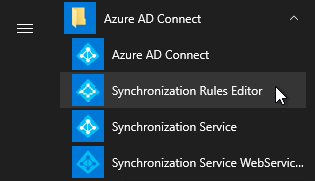
2. Click the Add new rule button on the View and manage your synchronization rules window.
3. Fill out the appropriate fields on the Description tab and click Next >.
4. On the Scoping filter tab, click Add group, then Add clause, add a userPrincipalName attribute filter, and click Next >.
Attribute: userPrincipalName -
Operator: ENDSWITH -
Value: Your internal UPN suffix prefixed with @ (e.g., @internal.acme.com). Users with this UPN suffix will NOT be synced with Office 365.
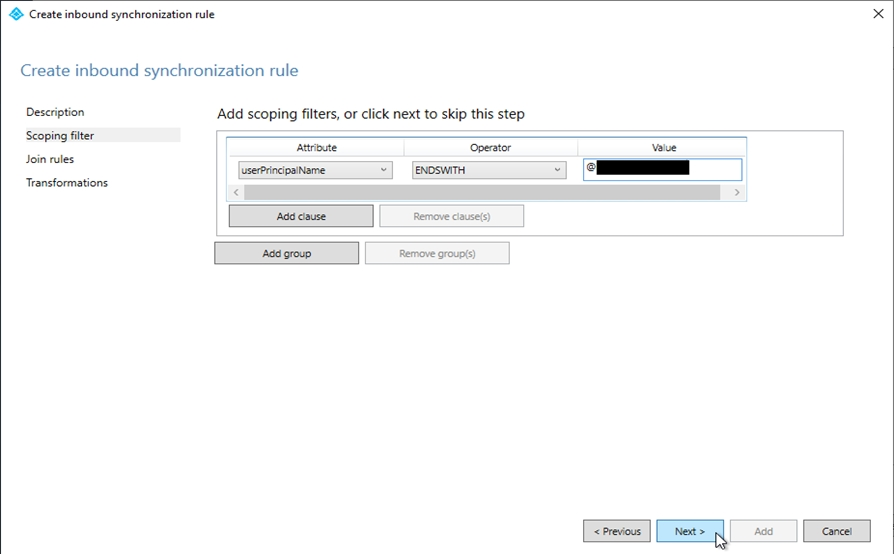
Reference:
https://www.sidekicktech.com/blog/field-notes/2019/upn-suffix-filtering-ad-connect/
A
Filtering what objects are synced to Azure AD is a common request and there are many instances where filtering by OU just doesn't cut it. One option is to filter users by their UPN suffix so that only users with the public FQDN as their UPN suffix are synced to Azure AD (e.g., [email protected] would be synced while [email protected] would not).
Filtering can be configured using either the GUI or PowerShell.
Through GUI:
Using The Synchronization Rules Editor
1. Open the Synchronization Rules Editor on the server where Azure AD Connect is installed.

2. Click the Add new rule button on the View and manage your synchronization rules window.
3. Fill out the appropriate fields on the Description tab and click Next >.
4. On the Scoping filter tab, click Add group, then Add clause, add a userPrincipalName attribute filter, and click Next >.
Attribute: userPrincipalName -
Operator: ENDSWITH -
Value: Your internal UPN suffix prefixed with @ (e.g., @internal.acme.com). Users with this UPN suffix will NOT be synced with Office 365.

Reference:
https://www.sidekicktech.com/blog/field-notes/2019/upn-suffix-filtering-ad-connect/
send
light_mode
delete
Question #27
Note: This question is part of a series of questions that present the same scenario. Each question in the series contains a unique solution that might meet the stated goals. Some question sets might have more than one correct solution, while others might not have a correct solution.
After you answer a question in this section, you will NOT be able to return to it. As a result, these questions will not appear in the review screen.
You manage an Active Directory domain named contoso.local.
You install Azure AD Connect and connect to an Azure Active Directory (Azure AD) tenant named contoso.com without syncing any accounts.
You need to ensure that only users who have a UPN suffix of contoso.com in the contoso.local domain sync to Azure AD.
Solution: You use the Synchronization Service Manager to modify the Active Directory Domain Services (AD DS) Connector.
Does this meet the goal?
After you answer a question in this section, you will NOT be able to return to it. As a result, these questions will not appear in the review screen.
You manage an Active Directory domain named contoso.local.
You install Azure AD Connect and connect to an Azure Active Directory (Azure AD) tenant named contoso.com without syncing any accounts.
You need to ensure that only users who have a UPN suffix of contoso.com in the contoso.local domain sync to Azure AD.
Solution: You use the Synchronization Service Manager to modify the Active Directory Domain Services (AD DS) Connector.
Does this meet the goal?
- AYes
- BNoMost Voted
Correct Answer:
B
Instead use Synchronization Rules Editor to create a synchronization rule.
Note: Filtering what objects are synced to Azure AD is a common request and there are many instances where filtering by OU just doesn't cut it. One option is to filter users by their UPN suffix so that only users with the public FQDN as their UPN suffix are synced to Azure AD (e.g., [email protected] would be synced while [email protected] would not).
Filtering can be configured using either the GUI (Synchronization Rules Editor) or PowerShell.
Reference:
https://www.sidekicktech.com/blog/field-notes/2019/upn-suffix-filtering-ad-connect/
B
Instead use Synchronization Rules Editor to create a synchronization rule.
Note: Filtering what objects are synced to Azure AD is a common request and there are many instances where filtering by OU just doesn't cut it. One option is to filter users by their UPN suffix so that only users with the public FQDN as their UPN suffix are synced to Azure AD (e.g., [email protected] would be synced while [email protected] would not).
Filtering can be configured using either the GUI (Synchronization Rules Editor) or PowerShell.
Reference:
https://www.sidekicktech.com/blog/field-notes/2019/upn-suffix-filtering-ad-connect/
send
light_mode
delete
Question #28
Note: This question is part of a series of questions that present the same scenario. Each question in the series contains a unique solution that might meet the stated goals. Some question sets might have more than one correct solution, while others might not have a correct solution.
After you answer a question in this section, you will NOT be able to return to it. As a result, these questions will not appear in the review screen.
You have an app named App1 that uses data from two on-premises Microsoft SQL Server databases named DB1 and DB2.
You plan to move DB1 and DB2 to Azure.
You need to implement Azure services to host DB1 and DB2. The solution must support server-side transactions across DB1 and DB2.
Solution: You deploy DB1 and DB2 to SQL Server on an Azure virtual machine.
Does this meet the goal?
After you answer a question in this section, you will NOT be able to return to it. As a result, these questions will not appear in the review screen.
You have an app named App1 that uses data from two on-premises Microsoft SQL Server databases named DB1 and DB2.
You plan to move DB1 and DB2 to Azure.
You need to implement Azure services to host DB1 and DB2. The solution must support server-side transactions across DB1 and DB2.
Solution: You deploy DB1 and DB2 to SQL Server on an Azure virtual machine.
Does this meet the goal?
- AYes
- BNo
Correct Answer:
A
Understanding distributed transactions.
When both the database management system and client are under the same ownership (e.g. when SQL Server is deployed to a virtual machine), transactions are available and the lock duration can be controlled.
Reference:
https://docs.particular.net/nservicebus/azure/understanding-transactionality-in-azure
A
Understanding distributed transactions.
When both the database management system and client are under the same ownership (e.g. when SQL Server is deployed to a virtual machine), transactions are available and the lock duration can be controlled.
Reference:
https://docs.particular.net/nservicebus/azure/understanding-transactionality-in-azure
send
light_mode
delete
Question #29
Note: This question is part of a series of questions that present the same scenario. Each question in the series contains a unique solution that might meet the stated goals. Some question sets might have more than one correct solution, while others might not have a correct solution.
After you answer a question in this section, you will NOT be able to return to it. As a result, these questions will not appear in the review screen.
You have an Azure Cosmos DB database that contains a container named Container1. The partition key for Container1 is set to /day. Container1 contains the items shown in the following table.
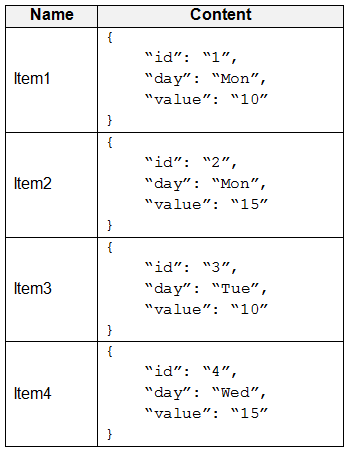
You need to programmatically query Azure Cosmos DB and retrieve Item1 and Item2 only.
Solution: You run the following query.
SELECT id FROM c -
WHERE c.day = "Mon" OR c.day = "Tue"
You set the EnableCrossPartitionQuery property to False.
Does this meet the goal?
After you answer a question in this section, you will NOT be able to return to it. As a result, these questions will not appear in the review screen.
You have an Azure Cosmos DB database that contains a container named Container1. The partition key for Container1 is set to /day. Container1 contains the items shown in the following table.

You need to programmatically query Azure Cosmos DB and retrieve Item1 and Item2 only.
Solution: You run the following query.
SELECT id FROM c -
WHERE c.day = "Mon" OR c.day = "Tue"
You set the EnableCrossPartitionQuery property to False.
Does this meet the goal?
- AYes
- BNo
Correct Answer:
B
Returns Item1 only as EnableCrossPartitionQuery property to False. If EnableCrossPartitionQuery property is set to true, it will return Item1, Item2, and Item3.
Reference:
https://docs.microsoft.com/en-us/azure/cosmos-db/sql-query-where https://docs.microsoft.com/en-us/dotnet/api/microsoft.azure.documents.client.feedoptions.enablecrosspartitionquery?view=azure-dotnet
B
Returns Item1 only as EnableCrossPartitionQuery property to False. If EnableCrossPartitionQuery property is set to true, it will return Item1, Item2, and Item3.
Reference:
https://docs.microsoft.com/en-us/azure/cosmos-db/sql-query-where https://docs.microsoft.com/en-us/dotnet/api/microsoft.azure.documents.client.feedoptions.enablecrosspartitionquery?view=azure-dotnet
send
light_mode
delete
Question #30
Note: This question is part of a series of questions that present the same scenario. Each question in the series contains a unique solution that might meet the stated goals. Some question sets might have more than one correct solution, while others might not have a correct solution.
After you answer a question in this section, you will NOT be able to return to it. As a result, these questions will not appear in the review screen.
You have an Azure Cosmos DB database that contains a container named Container1. The partition key for Container1 is set to /day. Container1 contains the items shown in the following table.
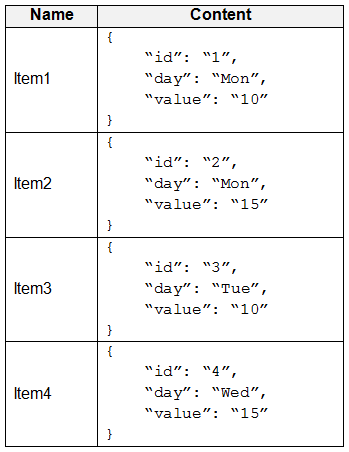
You need to programmatically query Azure Cosmos DB and retrieve Item1 and Item2 only.
Solution: You run the following query.
SELECT day FROM c -
WHERE c.value = "10" OR c.value = "15"
You set the EnableCrossPartitionQuery property to True.
Does this meet the goal?
After you answer a question in this section, you will NOT be able to return to it. As a result, these questions will not appear in the review screen.
You have an Azure Cosmos DB database that contains a container named Container1. The partition key for Container1 is set to /day. Container1 contains the items shown in the following table.

You need to programmatically query Azure Cosmos DB and retrieve Item1 and Item2 only.
Solution: You run the following query.
SELECT day FROM c -
WHERE c.value = "10" OR c.value = "15"
You set the EnableCrossPartitionQuery property to True.
Does this meet the goal?
- AYes
- BNo
Correct Answer:
B
Returns Item1, Item2, Item3, and Item4.
Reference:
https://docs.microsoft.com/en-us/azure/cosmos-db/sql-query-where
B
Returns Item1, Item2, Item3, and Item4.
Reference:
https://docs.microsoft.com/en-us/azure/cosmos-db/sql-query-where
send
light_mode
delete
All Pages

